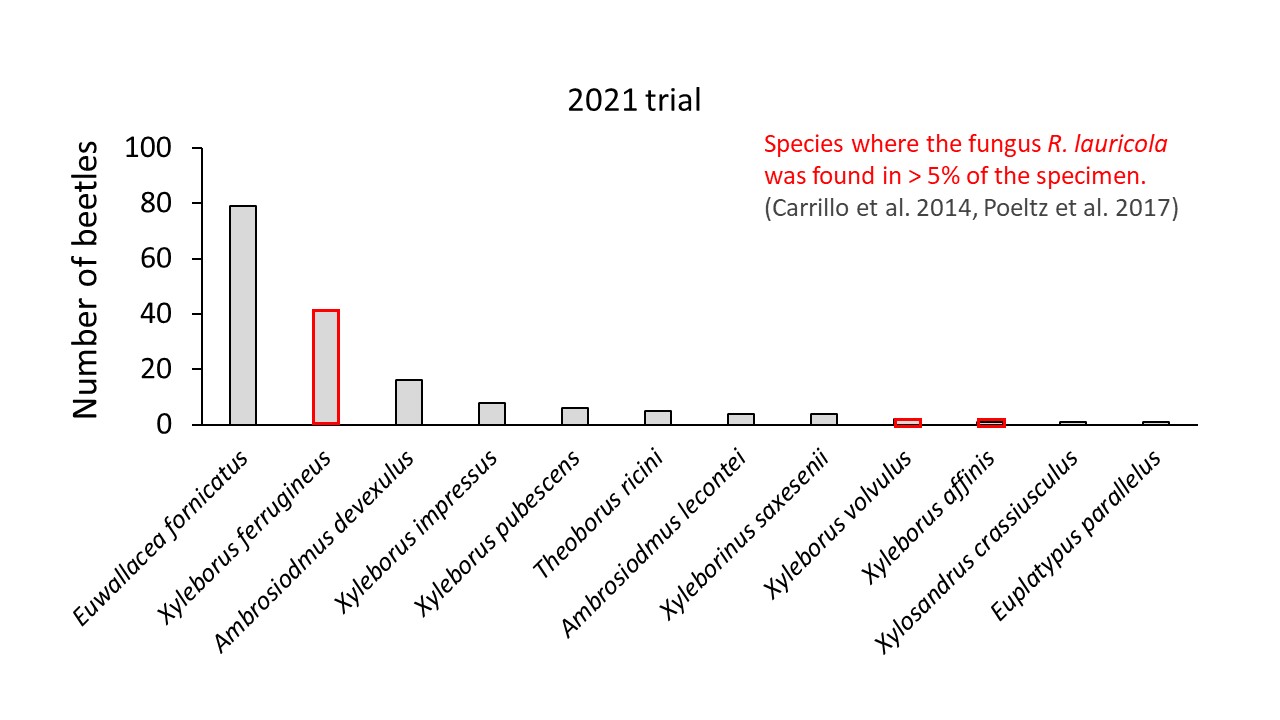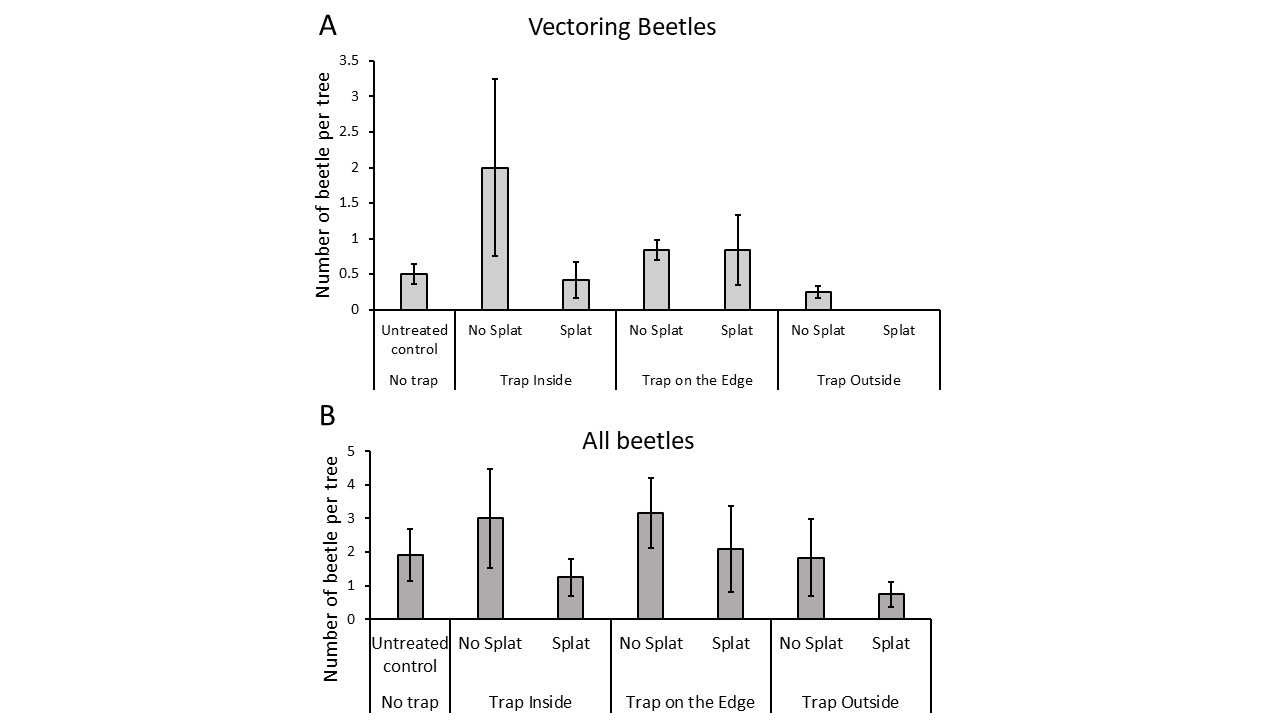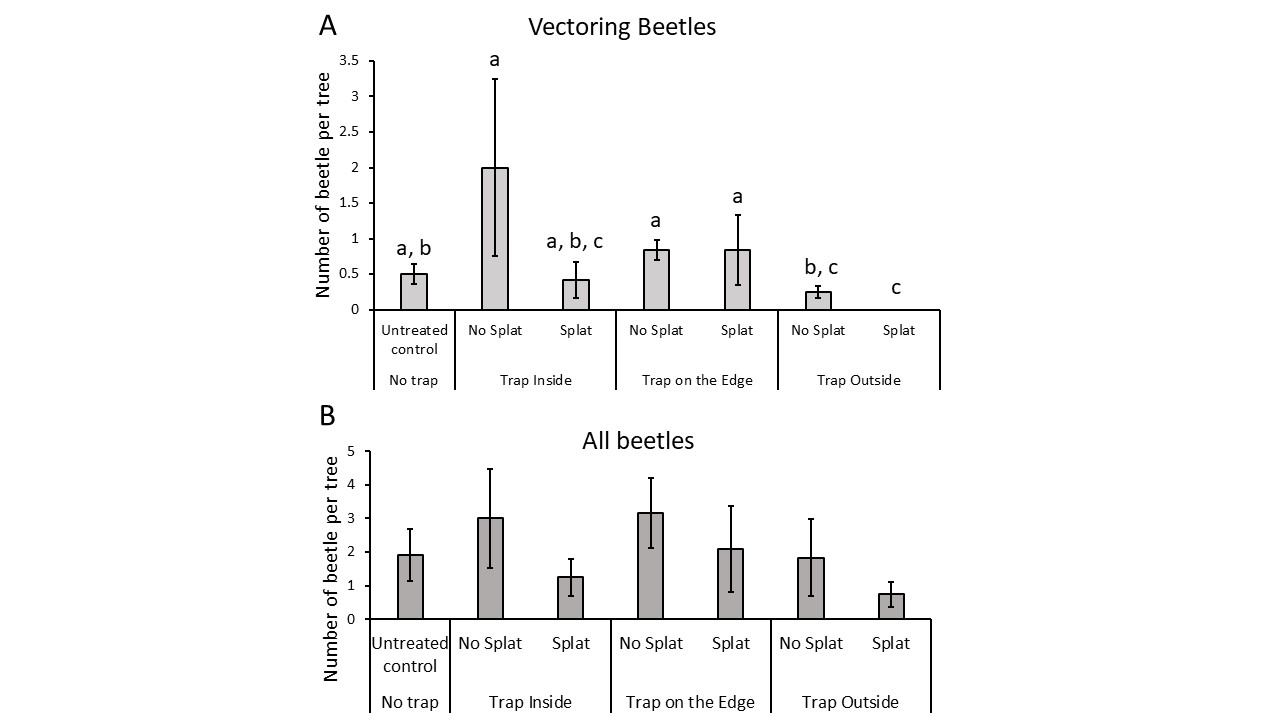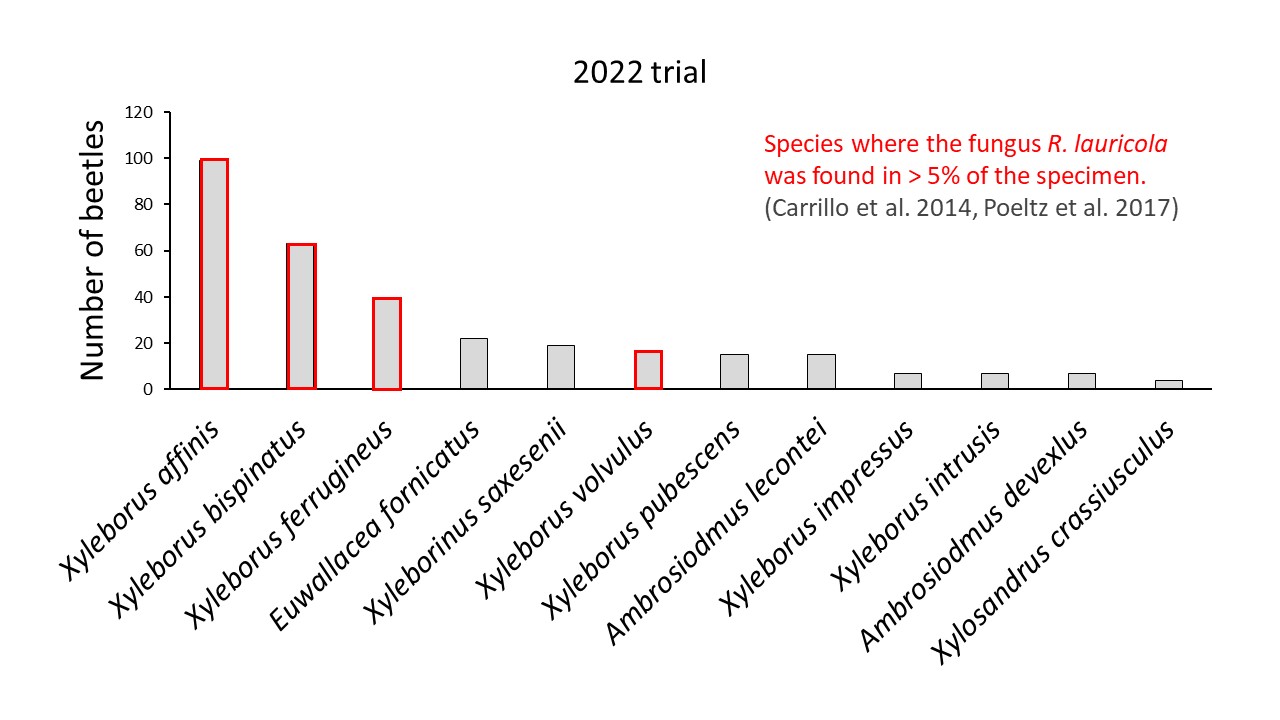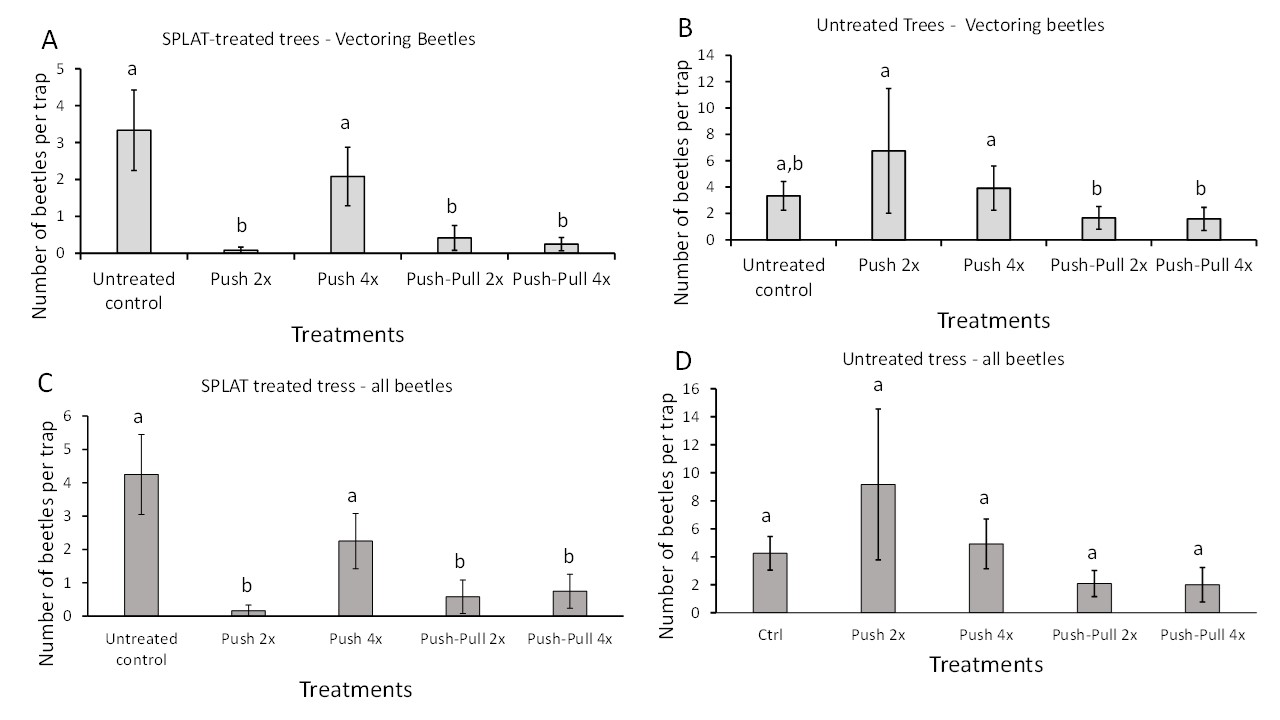Final report for GS20-234
Project Information
The Redbay ambrosia beetle, Xyleborus glabratus, is a major ecological pest of laurel trees causing widespread tree death by vectoring laurel wilt caused by the fungal pathogen Raffaelea lauricola. Laurel wilt also leads to considerable tree loss in avocado groves in South Florida by secondary vectors. Growers are facing increasing challenges in controlling ambrosia beetle populations in the southeastern region as they have become increasingly unpredictable, and it is difficult to prevent visitation and attack in host trees. To develop a more effective and sustainable integrated pest management program, alternative methods for ambrosia beetle control are being explored.
Chemical and visual stimuli play a dominant role in host searching behavior, and the implementation of visual traps that display attractive wavelengths shows great potential in reducing X. glabratus infestations. In addition, many natural repellents including verbenone can reduce ambrosia beetle visitation and mask attractive stress-related volatiles produced by laurel trees. Preliminary studies have shown that verbenone acts as a successful repellent of ambrosia beetles. However, until this project, little research has been done to investigate the efficacy of verbenone in combination with attractive visual and chemical lures as part of a complete IPM system.
This study we investigated the implementation of a “push/pull” system utilizing a combination of verbenone as a repellent (“push”) with attractive visual and chemical lures (“pull”) to reduce ambrosia beetle visitation in susceptible trees. We found that ambrosia beetle traps cosnisting a cylindrical cardboard covered with reflective mulch were particularly attractive to ambrosia beetles. When positioned outside the citrus grove (10 m away from the border) and in combination with verbenone, the number of ambrosia beetles captured was significantly reduced. Interestingly, avocado trees in the push-pull plots but not directly treated with verbenone also had their population of ambrosia beetle reduced. In summary, this study indicated that verbenone can reduce significantly the number of ambrosia beetles that vector the laurel wilt pathogen in avocado. The addition of an attractive lure outside the grove increased the efficacy of the system.
- Determine effects of trap placement on efficacy of attractive visual and chemical traps.
- Determine effects of complete “push-pull” strategy by combining the natural repellent verbenone (“push”) with the attractive visual and chemical traps (“pull”) compared to the traps alone.
Cooperators
- (Researcher)
Research
The experiments were conducted in two avocado groves from Brooks Tropical LLC located in Homestead, FL.
Objective 1: The objective of this experiment was to determine the best placement of ambrosia beetle traps within the grove to attract a maximum number of ambrosia beetles. The visual component of the traps tested included a cardboard cylindrical tube with an 8-inch diameter, covered in a UV-reflective material (Fig. 1). Preliminary tests demonstrated that the UV-reflective material was particularly attractive to ambrosia beetles. Each trap was baited with a slow-release lure of ethanol. The lures were commercially available pouch-style dispensers loaded with 10mL of 95% ethanol with a release rate of 65 mg/d at a constant 30°C (Standard Release ethanol lures, AgBio, Westminster, CO). A 15 x 18 cm white sticky card was placed on the trap to capture adult beetles as they land. In addition, avocado trees were treated with a repellent ('push' component of the 'push-pull' system). The “push” component consisted of Verbenone SPLAT (Specialized Pheromone and Lure Application Technology; ISCA Technologies, Riverside, California) provided in caulking tubes. Four 17.5 g dollops of Verbenone SPLAT, measuring 2 cm in diameter and totaling 70 g per tree, were applied equidistantly around the circumference of the tree at 1 – 1.5 m above ground level. White sticky cards were placed on live, non-symptomatic avocado trees within the grove to compare with captures on the trap (control treatments). Beetles were collected from the traps every 14 days and brought back to the lab to be counted and identified using the key published in Gomez et al. (2018).
The experiment was organized in a complete randomized design. The experiment lasted 2 months, and the ethanol lures were replaced each month. There were four treatments: 1) untreated avocados (control) 2) avocado treated with one ambrosia beetle trap within the avocado grove and 4 dollops per tree of Verbenone SPLAT (repellent), 3) avocados treated with one ambrosia beetle trap on the edge of the avocado grove and 4 dollops per tree of Verbenone SPLAT (repellent), 4) avocados treated with one ambrosia beetle trap outside (10 m) from the avocado grove and 4 dollops per tree of Verbenone SPLAT (repellent). Each treatment was replicated 4 times.
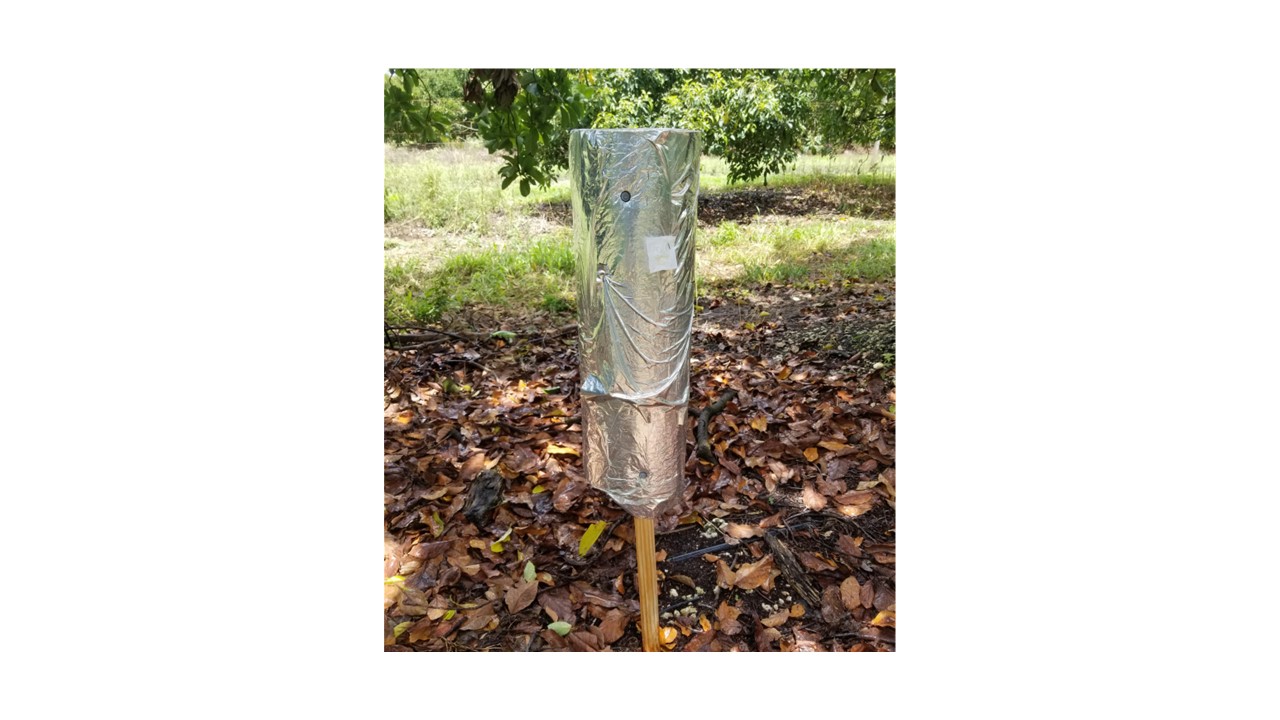
Objective 2: Data from Objective 1 were used to determine the optimal placement of the traps relative to the trees. We selected the placement 10 m away from the first row of trees (treatment 4 from Objective 1) to pull the beetles outside the grove.
The “push” component of this objective was similar than from Objective 1 and consisted of Verbenone SPLAT. Depending on the treatment, four to eight 17.5 g dollops of Verbenone SPLAT totaling 70 g or 140 g per tree, respectively, were applied around the circumference of the trees. However, in each plot only half of the trees were treated with SPLAT.
The experiment lasted 3 months. Treatments were organized in a split-plot design with the presence/absence of attractive traps applied to the whole plots, and the repellent treatments applied to the subplots. Subplots will consist of a 5 x 5 avocado tree square. Each subplot was separated by a single row of buffer trees. Whole plots were separated by two rows of buffer trees. There were five treatments: 1) untreated control 2) push only with 4 dollops of verbenone SPLAT 3) push only with 8 dollops of verbenone SPLAT, 4) full “push -pull” with trap + 4 dollops of verbenone SPLAT and 5) full “push-pull” with trap + 4 dollops of verbenone SPLAT. Each treatment was replicated 4 times.
Three white 15 x 18cm sticky cards will be attached 1.5 m from the base of three trees in the interior of each subplot. Within each experimental plot, sticky traps were placed on trees treated with the SPLAT and on trees non treated with the SPLAT. Our goal was to assess if trees not directly treated with SPLAT were still protected by the Push-Pull system. The ambrosia beetles were collected from sticky traps biweekly and were counted and identified to species in the laboratory. Ambrosia beetle species in the tribe Xyleborini were identified using the key published in Gomez et al. (2018).
Statistical analyses:
The number of ambrosia beetles captured were compared across treatments with appropriate mixed model analyses using either an ANOVA for normally distributed data or a generalized linear model using Poisson distribution if the data are Poisson distributed. When a significant difference was found (α=0.05), a Tukey test was conducted to determine which treatment(s) differed. To avoid pseudo-replication, separate analyses were conducted for each sampling date. We conducted separate analyses with the ambrosia beetles that are known to vector laurel wilt pathogen and those that do not (or the vector status is unknown). The vector status was based on reports from (Carrillo 2014, Ploetz 2017)
Gomez, D. F., Rabaglia, R. J., Fairbanks, K. E. O., & Hulcr, J. (2018). North American Xyleborini north of Mexico: A review and key to genera and species (Coleoptera, Curculionidae, Scolytinae). ZooKeys, 768, 19–68. https://doi.org/10.3897/zookeys.768.24697
Carrillo, D., Dunlap, C.A., Avery, P.B., Navarrete, J., Duncan, R.E., Jackson, M.A., Behle, R.W., Cave, R.D., Crane, J., Rooney, A.P. and Peña, J.E., 2015. Entomopathogenic fungi as biological control agents for the vector of the laurel wilt disease, the redbay ambrosia beetle, Xyleborus glabratus (Coleoptera: Curculionidae). Biological Control, 81, pp.44-50.
Ploetz, Randy C., Joshua L. Konkol, Teresa Narvaez, Rita E. Duncan, Ramon J. Saucedo, Alina Campbell, Julio Mantilla, Daniel Carrillo, and Paul E. Kendra. "Presence and prevalence of Raffaelea lauricola, cause of laurel wilt, in different species of ambrosia beetle in Florida, USA." Journal of Economic Entomology 110, no. 2 (2017): 347-354.
Results
Objective 1: 168 ambrosia beetles were collected during the field trial, from 12 different species. the dominant beetle was Euwallacea fornicatus. Out of the 12 species only 3 (Xyleborus ferrugineus, Xyleborus volvulus, Xyleborus affinis) are known to vector the laurel wilt pathogen (Carrillo 2014, Ploetz, 2017) (Fig. 1). We found a significant difference in the number of beetle captures depending on the placement of the attractive lures for the whole beetles count and for the beetle vectors only. Avocados in plots where the silver traps were placed outside the grove and with applications of repellent SPLAT had the least number of beetles landing on the trees. Conversely, when the silver traps were placed on the border or within the avocado groves, the number of beetles captured increased. SPLAT treatment significantly decreased the number of ambrosia beetles vectoring LW pathogens; however, this decrease was not significantly different for the total number of ambrosia beetles. No significant interaction was observed between the trap placement and the application of the repellent SPLAT for the whole beetle count and the beetle vectors only (Fig. 2).
Fig. 1: Number of Ambrosia beetles found during the 2021 field trial, per species. We indicate which ones are known to transmit laurel wilt pathogen.
Fig. 2: Number of ambrosia bettes (A) vectoring laurel wilt pathogen, and (B) total number of beetles (vector and non-vector) captured on avocado trees during the first field trial. During this experiment, we experimented with the position of the silvering trap. When the silvering trap was placed outside the grove, we observed a decrease in the number of vectoring beetles. Notably, no vectoring ambrosia beetle was captured on the treatment with SPLAT and trap placed outside. Different letters indicate significant differences (P<0.05).
Objective 2: 314 ambrosia beetles were collected during this experiment, and 12 species were identified. The dominant species was Xyleborus affinis. Out of the 12 species, four species (Xyleborus affinis, Xyleborus bispinatus, Xyleborus ferrugineus and Xyleborus volvulus) were known to vector the laurel wilt pathogen (Carrillo 2014, Ploetz, 2017) (Fig. 3). In this experiment, the treatment with SPLAT repellent significantly decreased the number of beetles captured on avocado trees. However, the number of beetles captured was not reduced with an increase of the SPLAT application, indicating that 4 dollops is sufficient to obtain the maximal control provided by SPLAT. On the whole number of beetles (non-vector and vector) the reflecting traps did not significantly decrease the capture of the beetles. However, there was a significant reduction in the number of beetles captured when traps were associated with SPLAT repellent for the vectoring beetles. This indicates that the reflecting traps increased the efficacy of the trapping system. All together SPLAT + reflecting trapping system provided an efficient push pull system that significantly decreased the number of beetle capture below 0.5 beetles per trap as compared to 3.33 beetles for the control group (Fig. 4).
Fig. 3: Number of Ambrosia beetles found during the 2022 field trial, per species. We indicate which ones are known to transmit laurel wilt pathogen.
Fig. 4: Number of ambrosia bettes (A) vectoring laurel wilt pathogen, and (B) total number of beetles (vector and non-vector) captured on avocado trees during the second field trial. During this experiment, we experimented the combination of the silvering trap and of the SPLAT repellent. The best control was obtained when SPLAT and the silvering trap were combined. Different letters indicate significant differences (P<0.05).
Discussion
Investigating and developing integrated pest management strategies and control tools are vital to prevent further spread to unaffected areas such as California (Mayfeild et al. 2013) and Mexico (Kendra et al. 2023). Laurel wilt has severely impacted the avocado industry in southern Florida. Researchers have determined that the redbay ambrosia beetle is not the primary vector(s) of H. lauricola, the causal fungal pathogen of laurel wilt in commercial avocado, but a complex of different ambrosia beetle species. Prior research showed that avocado is among the least attractive of the Lauraecae species to X. glabratus (Bates et al. 2023). Therefore, X.glabratus is rarely observed in avocado orchards (Kendra et al. 2023), which is further confirmed in our results; no X. glabratus were captured during all three field experiments.
Cases of laurel wilt in avocados appear to result from secondary ambrosia beetle species that acquire the pathogenic fungi by horizontal transfer in infected Lauracea (redbay or swamp bay) (Wood. 1982). In Florida, avocado groves are located across many natural areas severely impacted by laurel wilt (Hughes et al. 2017). Throughout South Florida, small urban forest patches (private and public) serve as a source of laurel wilt disease where various ambrosia beetles can acquire and migrate into avocado systems. Rivera et al. (2019) collected 16 species of ambrosia beetles in commercial avocado trials with multiple (X. crassisculus, X. bispinosa, and X. gracilis) confirmed vectors of H. lauricola (Carrillo et al.2014). While only a few alternative ambrosia beetle species have been identified to carry varying concentrations of H. lauricola, the conservative approach assumes all species can potentially promote pathogen spread in avocado systems.
The current study tested the effectiveness of combining repellents and attractants in a push-pull design to reduce the landing rates of ambrosia beetles on trees in an avocado system. Previous studies showed that multiple compounds could effectively repel ambrosia beetles from target trees, including myrcene, camphene, methyl salicylate, and verbenone (Hughes et al. 2017). Hughes et al. (2017) and later Martini et al. (2019) showed that verbenone, wax-like matrix called 'Specialized Pheromone and Lure Application Technology' (SPLAT) (ISCA Technologies, Riverside, CA, USA), reduced X. glabratus landings and borings on redbay trees and increased tree survival rates from 41.2% to 70.2% (Martini et al. 2019).
Our study concurred with Rivera et al. (2019) that splat has been shown to have a small effective repellent radius. In past studies, verbenone-releasing dispensers tested here were less than 1 meter. Thus, there would need to be a high density of these dispensers for practical application. Therefore, beetle repellents would likely need to be applied to every tree within a monoculture of avocado (Rivera et al. 2019). However, our results in experiment three show that the combination of traps (pull) with repellents (push) reduced the beetle capture on non-treated trees in the plots. Combined with the lack of an effect the different application volumes had, this could indicate that a push-pull system would reduce the required amount of repellent to be applied on trees in the groves.
Management is crucial to preventing and spreading laurel wilt within commercial avocado systems. Our current study and Rivera et al. (2019) show that a push-pull strategy may hold promise as a management tool for this pathosystem and deserves further investigation. However, push-pull may not be optimal as a standalone method and may function best with additional preventive measures such as removing infected trees.
Educational & Outreach Activities
Participation Summary:
Over the past two years I have worked with Broward County parks and recreation department on managing laurel wilt in their municipal parks and natural areas. I have visited and conducted field days in three different parks where I instruct and inform management staff on how to survey and identify the disease and the vectors and help them develop an IPM to reduce the number of infections and redbay loss in their parks. I have shared with them some of the findings and strategies we have developed to manage laurel wilt in redbay systems. I have also Distributed surveys to Parks and Forestry professionals to evaluate the common knowledge regarding laurel wilt to better understand what information is needed for effective outreach and extension materials. We participated in In-service training for University of Florida extension agents regarding insect vectors of plant diseases. We published a review article on current advances in the management of the redbay ambrosia beetle, the primary vector of laurel wilt (Martini et al. 2020). In addition, the graduate student supported by this grant also published the first article from his PhD thesis (Conover, Paris & Martini, In Press)
Martini X, Hughes MA, Conover D, Smith J. Use of Semiochemicals for the Management of the Redbay Ambrosia Beetle. Insects. 2020; 11(11):796. https://doi.org/10.3390/insects11110796
Conover D, Paris T, Martini X. Ecological dynamics of ambrosia beetle species in laurel wilt infected trees. Submitted to Biological Invasions. (in press)
Project Outcomes
Our project has contributed to a pest management system in avocado with the objective of prevention. By incorporating a push pull system into an overall management protocol, growers can reduce ambrosia beetle damage on their trees. The silvering traps we designed and that are part of the push-pull system are low tech and inexpensive when deployed appropriately. The materials used in our push pull system do not affect the fruit yield of the trees or the environment and can be utilized by commercial growers, government agencies and private citizens to protect tree's. We hope to demonstrate this control method to avocado growers in future Extension meetings. For organic growers we believe that the method we developed is currently the only solution available for them to control laurel wilt and ambrosia beetle in their crop.
This project reinforced that utilizing semiochemical methods for pest management can be an effective means of reducing damage on crops. In this particular case, when a pest (ambrosia beetles) has a cryptic life cycle that protects them from insecticide control, manipulating the pest's behavior can give a manager alternative means of control. With this system, we are able to control vector of a deadly pathogen could be reduced without the use of insecticides. Reduction of insecticide needs is an important component of sustainable agriculture.
It would be interesting to examine the delivery methods of the repellents within avocado grove systems. While we deployed a slow-release wax matrix (SPLAT) onto the trunk of the trees, there are multiple product designs for repellent delivery. Thes alternatives include slow-release pouches and bubble caps. Determining if one method is better than another or if they are equal in effect would be beneficial to growers. Another question not addressed in this study is the timing of the reapplication of the SPLAT repellent. While our industrial partner ISCA technology recommends a reapplication every 3 to 4 months a more detailed study would be beneficial for the industry. Finally, the economic cost of this method as compared to the traditional ones used to control laurel wilt (insecticide, fungicide trunk injection) should also be conducted.
